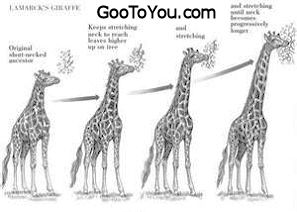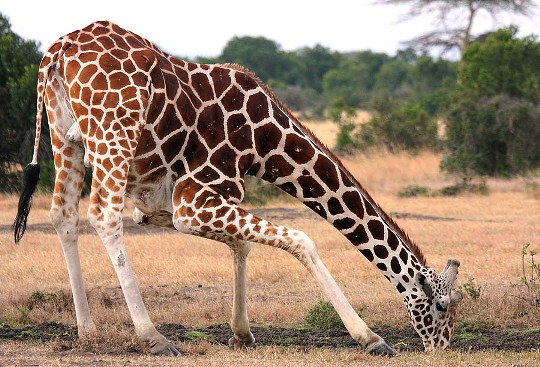

The Giraffe as Being Irreducibly Complex
Irreducible complexity does not just relate to molecular machines, Irreducible complexity can be applied on a much larger scale as well. The Giraffe according to evolutionary theory evolved from the Climococeras. The Climococeras, as you can see had a much smaller neck than the giraffe does. So in evolving into a giraffe, one of the most obvious steps would be a longer giraffe. So according to natural selection every few generations there would be a giraffe with a longer neck enabling it to survive more easily than its counterparts. However, the giraffe’s neck is to long for a normal heart to pump blood efficiently. So at some point during the evolutionary process the Climococeras would not be able to have a larger neck. If the neck grew any larger the offspring would quickly die from a lack of oxygen. Now we know that the giraffe’s neck is too long for a normal heart, so obviously something happened to enable the neck to continue to grow.
So to solve the problem a more powerful heart evolves. Now here is the problem, the evolutionary process cannot think ahead. It’s a process not a person. So how would evolution know to build a stronger heart when it is not immediately beneficial to the creature? In order to be beneficial to the organism that organism would need additional evolutionary steps and evolution is built upon the notion that beneficial traits are preserved and non-beneficial traits are dispensed with. So the next time the creature would have evolved, the neck would not grow longer. Evolution would replace the more powerful heart with a weaker heart, because the newer heart serves no purpose. However, there is another, greater problem. The Climococeras the heart would be too powerful. The heart would pump the blood to the brain, and the brain would explode due to force of the blood’s impact. Now I think we can both agree that an exploding brain would kill the Climococeras.
Now the Giraffe does have a special sponge that absorbs the oxygen carrying blood and then slowly releases the blood so oxygen can reach the brain. This sponge is not used when the Giraffe is standing up, because the heart is pumping against gravity and the blood is traveling a fairly long distance so the sponge isn’t used to deaden the impact at this point. The sponge is used when the Giraffe bends down to drink. When the Giraffe bends down, the heart is no longer pumping against gravity but with gravity. This obviously would increase the force of the bloods impact against the brain. However, the sponge solves this by deadening the force while still allowing the brain to receive the needed oxygen. So for the climococeras to evolve into a giraffe, the sponge would have to evolve before the heart evolved, which had to evolve before a longish neck could evolve. So evolution would need to create a tissue to enable an improved organ to evolve to allow the neck to grow. And, once again, evolution cannot act with forethought evolution would get rid of the sponge before the heart evolved and the heart would kill the climococeras before the neck could grow longer.
Thus the giraffe shows that evolution cannot be responsible for changing an organism into a completely different organism. Organisms are Irreducibly Complex. For an organism to change you would need multiple key traits to evolve that on their own would serve no purpose and so be discarded when the organism evolved next. If the new trait did not kill the organism like the powerful heart would have killed the climococeras
Giraffes in Antigravity Suits (CreationMoments.com)

Job 39:19 Hast thou given the horse strength? hast thou clothed his neck with thunder?
There are wonderful designs that help make the giraffe possible. The giraffe has a strong heart to pump blood all the way up to its head and strong arteries to withstand the high blood pressure needed to carry the blood to its head. We have also talked about the giraffe's so called wonder net," which is a network of blood vessels that helps to stabilize the blood pressure in the giraffe's head even when it raises and lowers its head.
But modern science continues to uncover engineering wonders that enable the giraffe to keep blood flowing evenly to its brain and keep blood from pooling in its legs. Researchers have discovered that giraffes, unlike human beings, have a valve in the jugular vein. But these valves work in the wrong direction to help blood stay in the head. Instead, they close when a giraffe lowers its head, preventing used blood from backing up into the brain.
And how does a giraffe, which stays on its feet all day, keep blood from pooling in its legs? Scientists have found that the skin on a giraffe's legs is very tight fitting. When a giraffe walks, its muscle movement within that tight skin actually helps pump used blood out of the legs.
If life owed its existence to chance and genetic mistakes, we wouldn't have any giraffes today. But what a wonder of God's design these stately creatures are!
Creation.com (Credit To Creation.com) Giraffes Did Not Evolve (Credit To Creation.com)
Far more than just a beautiful and impressive animal to look at, the giraffe has a whole range of interesting design features. These mostly either involve supporting its amazing neck or are in some way related to it. Long and powerful, this 225 kilogram (500 pound) structure enables the giraffe to reach foliage that other species can only dream of.
Yet, despite its impressive size, the giraffe’s neck still contains just seven cervical vertebrae (neck bones). This is the same as most other mammals—but the giraffe’s vertebrae are of course longer (up to 25 cm = 10 in) and they are bound together with ball-and-socket joints. This is the same kind of joint that links our arm to our shoulder, giving a 360-degree range of motion. So the bony structure of the giraffe’s neck demonstrates an excellent balance of weight, flexibility and durability. Indeed, so durable is a giraffe’s neck, that adult males will enthusiastically club one another with them in order to win mates.
To further assist in supporting the neck, the vertebrae over the shoulders have long vertical extensions, which allow for a very large ligament (the nuchal ligament, which runs from the back of the skull all the way down to the base of the tail, but it is at its thickest just over the shoulders). This ligament helps counteract the weight of the giraffe’s head and neck, acting like a giant rubber band, pulling the neck up. This means very little muscular energy is required to hold the head up.
Having one’s head perched approximately 5.5 metres (18 ft) in the air may provide an excellent view and premium browsing options, but it does pose the problem of how to get the blood all the way up there. The higher you need to push a liquid up a pipe against gravity, the more powerful a pump you need. Thankfully, the Creator knew about this and furnished the giraffe with a suitably large heart (up to 60 cm (2 ft) long in an adult male), which generates a blood pressure about twice that of a human or other large mammal. The artery walls have extra elasticity to ensure that they can handle this high pressure close to the heart. Furthermore, to prevent the blood from rushing too quickly back down the neck again, the jugular veins in the neck partially contract to restrict return flow.
Now this is all very well for when the giraffe is walking around with its head up, but what about when it wants to take a drink? When it lowers its head, all that high pressure blood would likely rush downhill (further assisted by gravity) and blow out the delicate blood vessels in the brain and eyes—if it weren’t for a series of clever mechanisms working in concert with one another. When the head is lowered, special shunts in the arteries supplying the head restrict blood flow to the brain, diverting it into a web of small blood vessels (the rete mirabile or ‘marvellous net’). This network of vessels near the brain gently expands to accommodate the increased local blood pressure. Valves in the jugular veins also prevent returning blood from flowing backward while the head is lowered.
All of this is controlled by a complex series of mechanisms that constantly monitor the pressure in the blood vessels and make whatever adjustments are needed to ensure that the proper pressure is maintained in all situations. This means that even if the giraffe lifts its head up quickly mid-drink (perhaps in response to a nearby lion), proper blood supply is maintained to the brain, so that the giraffe doesn’t faint (probably much to the lion’s disappointment—a giraffe can kill a lion with its powerful kick).
Of course, this high blood pressure, combined with the effect of gravity on such a tall body, would also be a problem for the giraffe’s legs. The animal would bleed profusely from any cut, and there is a very real danger of blood pooling in the lower extremities. To combat this, the skin on the giraffe’s legs is extremely tough, and tightly fitted by way of a firm inner fascia to prevent blood pooling. (This has been studied by NASA scientists developing the special ‘gravity-suits’ worn by astronauts to help maintain correct circulation while in space.) To prevent excess bleeding, the blood vessels in the giraffe’s legs run deep (away from the skin’s surface), and those capillaries that do reach the surface are very narrow, with blood cells only 1/3 the size of ours. Additionally, these smaller blood cells allow for faster absorption of oxygen, ensuring a good supply to the extremities of such a large animal.
Many have asked how the giraffe got all these interesting features. Some suggest that you can start with a non-giraffe and, through successive small changes, end up with a giraffe. However, the fossil evidence of giraffes in the past shows them to be much the same as the ones we see in Africa today. Fossil evidence of transitional forms, or ‘not-quite-giraffes’, is “completely lacking”. The selective advantage of a long neck for reaching higher leaves in a drought is often discussed, but this does not account for the survival of baby giraffes (who are unable to reach this food supply). And female giraffes would have a selective disadvantage because they are shorter. In addition, giraffes spend a good portion of their time, legs splayed, browsing grass or low-lying shrubs.
In any case, the idea that the neck became elongated stepwise over successive generations under environmental/selection pressures is now shown to be a great deal more complex than previously thought, with a whole assortment of structures and systems that need to be in place to accommodate the long neck. Many of these features involve and affect parts of the body seemingly unrelated to the neck, but nonetheless connected through the necessities of function or support. It illustrates the point that an organism is a finely balanced collection of interconnected (and often interdependent), systems. And the only One who can achieve such a delicate balancing act is God who designed it in the first place.
Gen1.org (www.Gen1.org and www.FineTunedUniverse.com are the same website.)
Starlight And The Age Of The Universe
Young Blue Stars Found In Milky Way
Click on book to read or click this link Creation Answers Book Creation.com
20 Chapters (More than 60 of the most asked questions about Creation, evolution, and the book of Genesis answered!)
Chapter 3: What about gap theories? ![]()
Chapter 4: What about carbon dating? ![]()
Chapter 5: How can we see stars in a young universe? ![]()
Chapter 6: How did ‘bad things’ come about? ![]()
Chapter 7: What about arguments for evolution? ![]()
Chapter 8: Who was Cain’s wife? ![]()
Chapter 9: Were the 'Sons of God' and/or nephilim extra-terrestrials? ![]()
Chapter 10: Was the Flood global? ![]()
Chapter 11: What about continental drift? ![]()
Chapter 12: Noah’s Flood—what about all that water? ![]()
Chapter 13: How did the animals fit on Noah’s Ark? ![]()
Chapter 14: How did fresh and saltwater fish survive the flood? ![]()
Chapter 15: Where are all the human fossils? ![]()
Chapter 16: What about the Ice Age? ![]()
Chapter 17: How did the animals get to Australia? ![]()
Chapter 18: How did all the different ‘races’ arise? ![]()
Chapter 19: What about dinosaurs? ![]()
Fine Tuned Universe CREATED BY GOD BY Design. The Heavens Declare The Glory Of GOD. Also Get FINE TUNED UNIVERSE On Your ROKU Player. EVOLUTION 101 (25 FREE LESSONS FOR STUDENTS AND TEACHERS). TAKE THE EVOLUTION TEST (EVOLUTION FLUNKED THE SCIENCE TEST! (PDF FILE)
Gen 1:1 In the beginning God created the heaven and the earth.
Some people accept evolution as fact despite the millions or billions of years explanation that is NO explanation of anything.
Gen 1:1 Explains Creation.
God created everything in six 24 hour days and rested on the 7th day.
Psalm 19:1-3 19:1 The heavens declare the glory of God; and the firmament sheweth his handywork. 19:2 Day unto day uttereth speech, and night unto night sheweth knowledge. 19:3 There is no speech nor language, where their voice is not heard.
www.FineTunedUniverse.com Refutes, disproves, discredits, invalidates, contradicts, rebuts, opposes and denies evolution theories that claim the universe was created from nothing or that the universe has evolved over millions or billions of years.
www.Gen1.org Refutes, disproves, discredits, invalidates, contradicts, rebuts, opposes and denies evolution theories that claim the universe was created from nothing or that the universe has evolved over millions or billions of years.
www.Gen1.org and www.FineTunedUniverse.com are the same website.
Bookmark www.Gen1.org or www.FineTunedUniverse.com
www.Gen1.org is a shorter domain name for www.FineTunedUniverse.com
GoodNewsPost.com (KJV) Bible Evolution 101 (25 FREE Lessons Proving Evolution Is False)
TAKE THE EVOLUTION TEST (EVOLUTION FLUNKED THE SCIENCE TEST! (PDF FILE)
SIX 24 HOUR DAYS OF CREATION EVOLUTION'S MILLIONS OF YEARS OF CREATION DISPROVED/REFUTED!
BIBLICAL EVIDENCE THAT THE FLOOD WAS A YEAR-LONG, GLOBAL CATASTROPHE
READ THE ONLINE BOOK (EVOLUTION IS A RELIGION)
The Creation Answers Book (20 Chapters) (FREE online book that denies/ invalidates evolution.)
AnswersInGenesis.org Institute Of Creation Research (ICR.org) Creation.com Northwest Creation Network (NWCreation.net

Psalm 19:1-3 19:1 The heavens declare the glory of God; and the firmament sheweth his handywork. 19:2 Day unto day uttereth speech, and night unto night sheweth knowledge. 19:3 There is no speech nor language, where their voice is not heard.
Genesis 1:1, "In the beginning (time), God created the heavens (space) and the earth (matter)."
John 3:16 "For God so loved the world that he gave his only begotten son, that whosoever believeth in Him should not perish, but have everlasting life."
We all see the evidence of God's creation. How we interpret what we see helps us make sense of this present world. The Bible, the “history book of the universe”, provides a reliable, eye-witness account of the beginning of all things. When properly understood, the “evidence” confirms the biblical account. The universe is "fined tuned" for life, ie designed by a designer, creator, The Lord GOD Almighty.